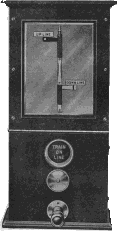|
THE SIGNAL BOX |
BLOCK SYSTEM |
 |
BLOCK SYSTEMUntil the railways were nationalised in 1948, there was considerable variance between the working practices of the different railway companies although the underlying principles were the same. In 1950, the first British Railways Rule Book was issued, and this was followed by the British Railways Regulations for Train Signalling in 1960, although a few regional variations persisted. To describe all of the different companies' practices would be a mammoth and confusing task, so for consistency in the section, all details refer to the above publications unless otherwise stated. A range of photographs of interesting signalling instruments is now included with this section. There are several chapters to this section, and these are listed below.
|
Home Signals Block System Branch Lines Photo Gallery Museums & Pubs Companies & Contractors Section C Track Layouts Overseas Latest Magazines Book Shelf Lever Frames Exchange Sidings Rule 55 Signal Links